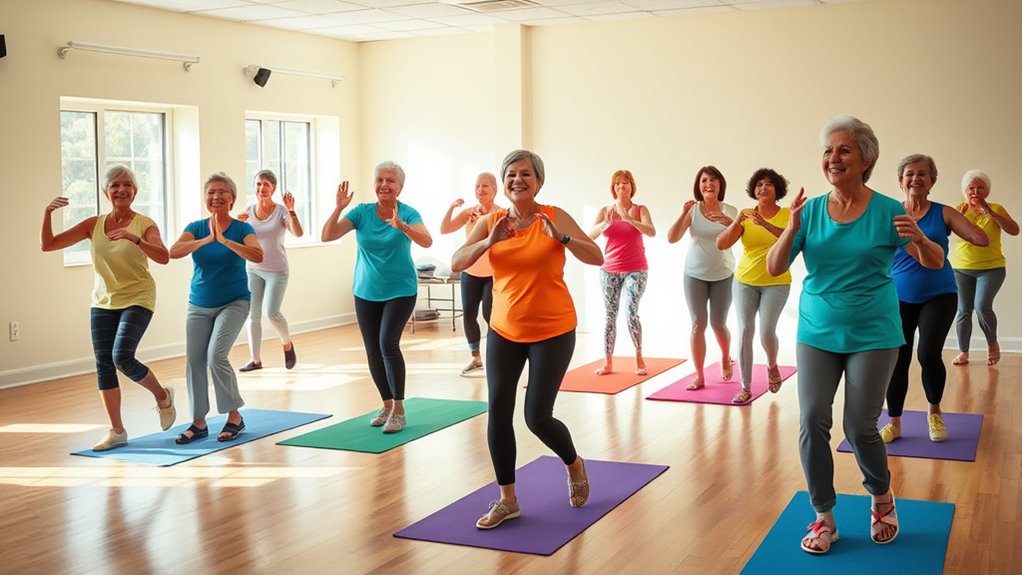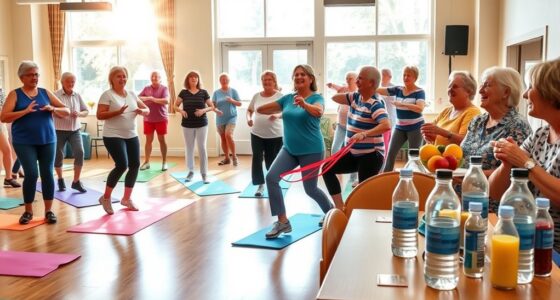Exercise classes can keep you active and thriving as you age. They boost your physical health, improve mental well-being, and enhance social connections. You’ll find a variety of options like chair yoga, tai chi, and swimming that cater to different mobility levels. Engaging in these classes not only supports your independence but also promotes friendship and camaraderie. And there’s so much more to discover about choosing the right program that fits your needs and interests.
Key Takeaways
- Popular exercise classes for seniors include chair yoga, tai chi, swimming, and cycling, catering to various mobility levels and interests.
- Group classes foster social connections and reduce feelings of isolation, enhancing motivation to stay active among participants.
- Community-based programs often provide free or low-cost options, making it easier for seniors to participate regularly.
- Customized exercise routines, including strength training and balance activities, promote overall health and prevent injuries for seniors.
- Utilizing fitness apps can help seniors track progress and maintain motivation, ensuring they stay engaged in their exercise routines.
Physical Benefits of Exercise for Seniors
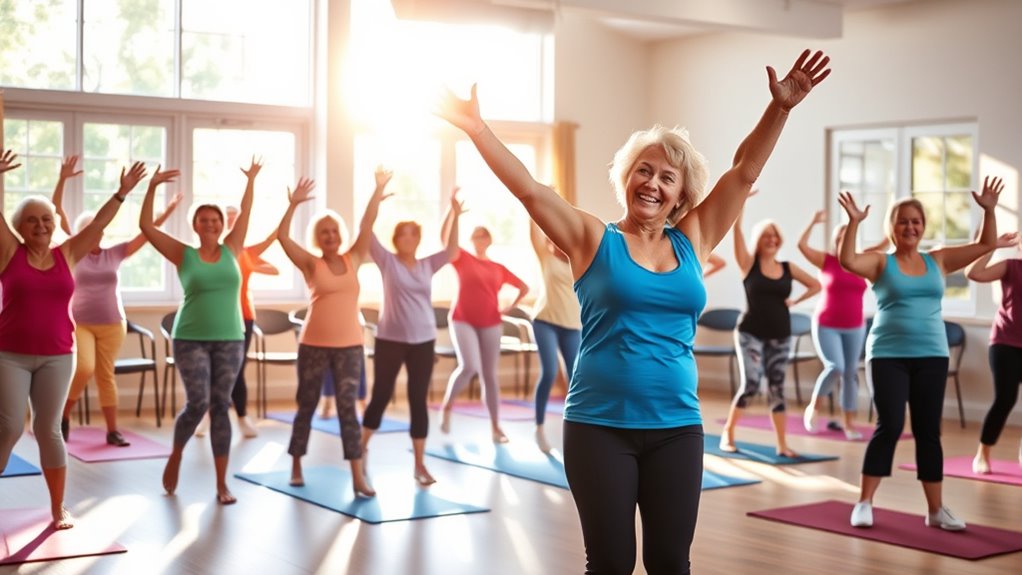
When you engage in regular exercise, you’re not just staying active—you’re enhancing your overall physical health. This is especially true for seniors, as exercise helps maintain and improve muscle strength, flexibility, and balance. Additionally, incorporating smart technologies into your routine can further enhance your quality of life by making daily tasks more manageable. Regular physical activity can also provide emotional and psychological support for seniors, contributing to improved mental well-being. Furthermore, engaging in activities that promote social interaction can be beneficial for cognitive health, especially for those at risk of conditions like dementia. Participating in cultural festivals and community events can also provide opportunities for seniors to socialize and stay active.
By incorporating physical activity into your routine, you can reduce the risk of chronic diseases like heart disease, diabetes, and arthritis. It also aids weight management and boosts cardiovascular health by lowering blood pressure and improving heart function. Additionally, regular exercise can reduce healthcare costs associated with chronic diseases, making it a wise investment in your health.
Incorporating physical activity into your routine helps lower chronic disease risks and promotes better cardiovascular health.
Strength training can enhance bone density, reducing fracture risks, while alleviating osteoarthritis symptoms by strengthening the muscles around your joints.
Ultimately, staying physically active enables you to perform daily tasks with greater independence and enjoy hobbies that enrich your life.
Mental Well-being Through Physical Activity
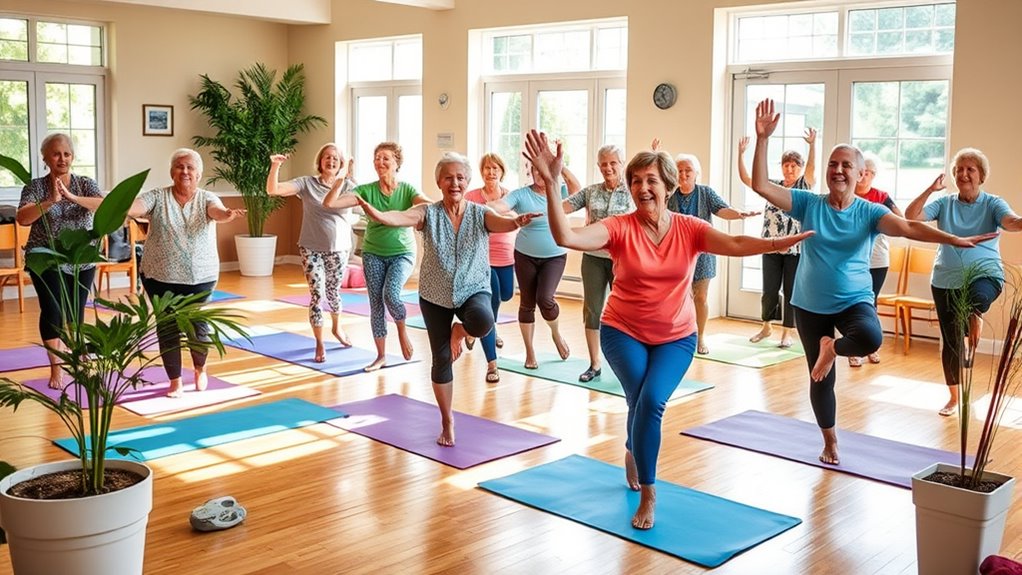
Engaging in regular physical activity can greatly enhance your mental well-being, especially as you age. Exercise reduces anxiety and depression, helping you feel calmer and more balanced. It releases endorphins, boosting your mood and reducing stress levels. You’ll also find that staying active improves your sleep quality, allowing for more restorative rest.
Moreover, physical activity helps mitigate cognitive decline, keeping your mind sharper and reducing the risk of declining mental health. Regularly engaging in exercise can also help prevent feelings of running dry, ensuring that you maintain your energy and enthusiasm for life. As you participate in exercise, you’ll notice a boost in your self-esteem and confidence. Regular engagement in physical activity can also help you navigate trust issues with boyfriend no-shows, fostering a sense of connection and support within your community. Additionally, incorporating exercise into your routine enhances your cultural intelligence, which can enrich your interactions with others. Engaging in physical activity is a powerful way to unlock the magic of the Vortex, enhancing your overall mental health and emotional well-being.
Incorporating exercise can also lead to improved overall health, which in turn supports mental well-being. Whether it’s through aerobic workouts, yoga, or strength training, each movement contributes to your overall mental health. By prioritizing physical activity, you’re investing in a happier, healthier mind.
Enhancing Social Engagement With Group Classes
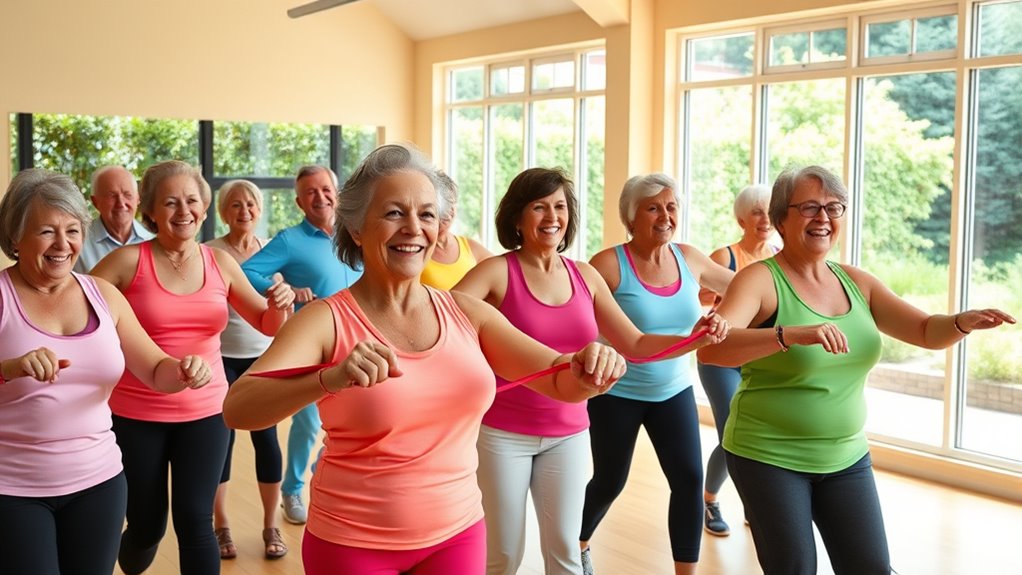
Group classes offer a fantastic opportunity for seniors to enhance social engagement while staying active.
These sessions help reduce feelings of loneliness and isolation, providing regular interactions that foster friendships and a sense of community. You’ll share goals, celebrate successes, and encourage one another in a supportive environment. Many classes even integrate social hours, encouraging more interaction. Activities like balloon bounce promote teamwork and friendly competition, which strengthens bonds. Additionally, engaging in group activities can help address identified triggers that lead to behavioral outbursts in seniors. Moreover, the emotional connection formed in these classes can mitigate some of the impact of parental infidelity on seniors, highlighting the importance of supportive relationships. Engaging in meaningful activities can significantly enhance overall life satisfaction for seniors, creating a more fulfilling daily routine. Participating in these group classes can also foster a growth mindset, encouraging seniors to embrace new challenges and learn from each other. Furthermore, the benefits of group camping experiences can also inspire seniors to connect with nature and each other during outdoor activities.
Instructors play an essential role in creating a welcoming atmosphere. By engaging in age-specific classes, you’ll feel comfortable and motivated. Ultimately, these social connections not only make exercise enjoyable but also contribute greatly to your overall well-being, reducing risks of depression and anxiety. Additionally, participating in group fitness can enhance strength, flexibility, and balance, reducing the risk of falls and promoting independence.
Overview of Popular Exercise Programs
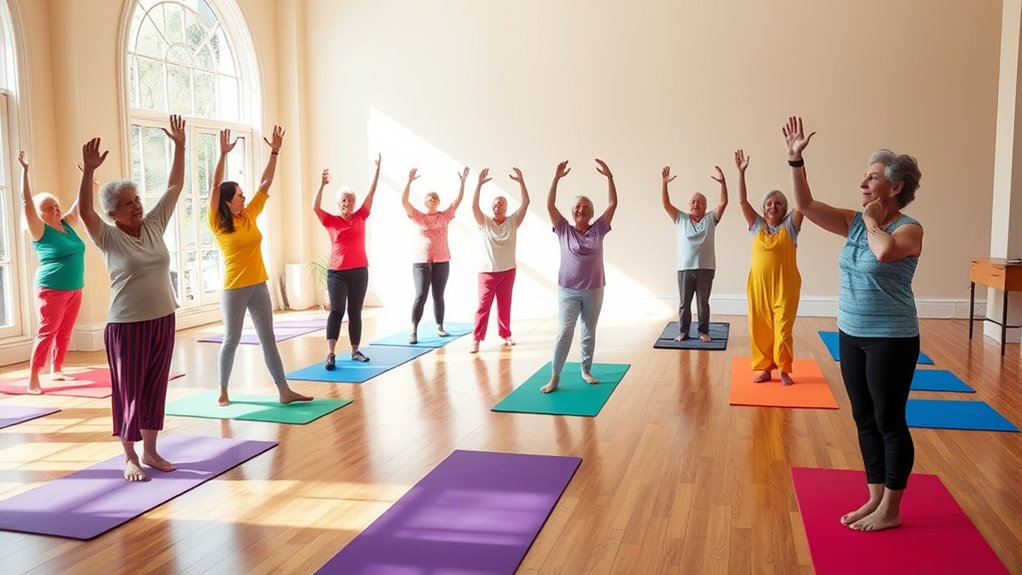
Exploring various exercise programs can greatly enhance your fitness journey as a senior. Options like chair yoga improve muscle strength and flexibility without stressing your joints. Cycling offers a low-impact cardiovascular workout, while Pilates focuses on core strength and balance. If you prefer the water, swimming provides a full-body workout that’s gentle on your body, similar to the experiences found in water parks. Tai Chi enhances balance and flexibility through slow movements, which is beneficial for maintaining emotional needs and overall well-being. Regular exercise not only boosts energy levels but also promotes better mental health and cognitive function in older adults, aligning with the importance of customer feedback for optimal program effectiveness. Additionally, incorporating strong communication skills into group classes can enhance social interaction and motivation among participants.
Moreover, understanding the importance of emergency preparedness can also empower seniors to stay active and safe during unexpected events. You can also consider structured programs like EnhanceFitness, which combines strength training and aerobics, or Geri-Fit, focused on resistance training. For those looking for fun, Bingocize blends exercise with bingo. These programs not only boost your physical health but also support your overall well-being, making it easier to stay active and engaged.
Recommended Guidelines for Senior Fitness
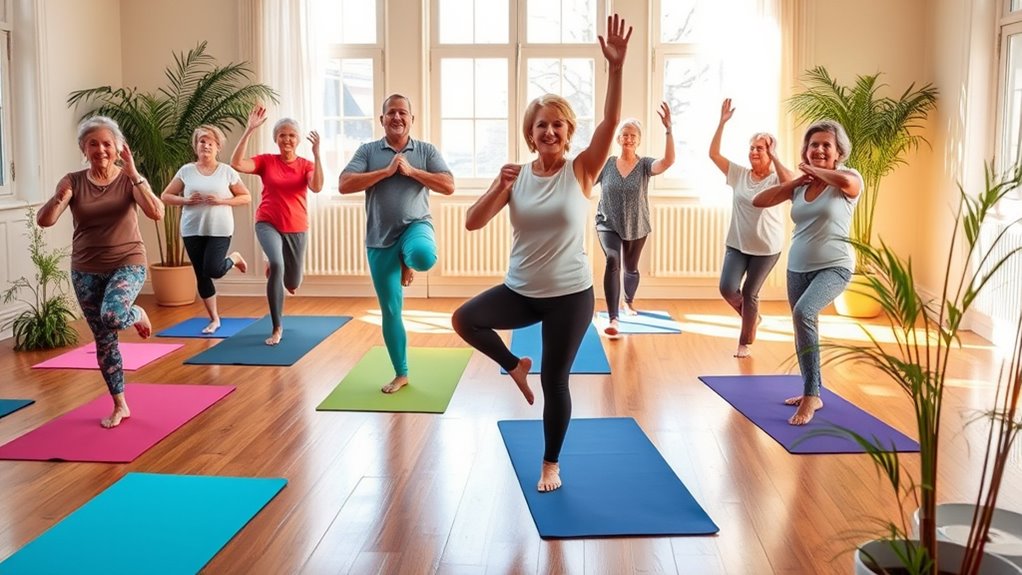
While maintaining a regular exercise routine can be challenging, following recommended guidelines for senior fitness can make it easier and more effective. Aim for at least 150 minutes of moderate-intensity aerobic activity each week, or opt for 75 minutes of vigorous activity. Spread these activities throughout the week to enjoy ideal benefits. Incorporate muscle-strengthening exercises for all major muscle groups at least twice a week, using weights or resistance bands. Additionally, engaging in regular exercise can help improve your credit score by promoting a healthier lifestyle, which may lead to lower medical costs. Regular physical activity can also support mental stimulation, helping to enhance cognitive function and overall well-being. Research supports that exercise can also boost mood and mental clarity, further enhancing your quality of life. It is essential to build resilience through structured routines, as they can help maintain motivation and consistency in your fitness journey. Engaging in physical activities can also lead to improved emotional and psychological growth, which is crucial for overall well-being. Don’t forget to include balance and flexibility activities like tai chi or yoga, improving your range of motion and reducing stiffness. Staying active contributes to overall quality of life and independence, so count everyday activities, like gardening or grocery shopping, as part of your fitness routine to stay active and engaged.
Safety Considerations in Exercise Classes

When you participate in exercise classes, prioritizing safety is essential to guarantee a positive and effective experience. Start by consulting your healthcare provider, especially if you have chronic conditions. Engaging in regular physical activity can also help manage unresolved grief, which is important for overall well-being. Regular exercise can improve cardiovascular health, which is crucial for overall well-being and may also reduce the risk of developing common health concerns like obesity and heart disease. Additionally, staying active can help lower the risk factors associated with various health issues, including certain cancers. Incorporating a balanced diet with low carb high protein options can also support your energy levels during workouts. Including juices rich in vitamins can provide essential nutrients that further enhance your health.
Incorporate warm-up and cool-down routines to prevent soreness and lightheadedness. Opt for low-impact activities to minimize joint stress, and stay hydrated before, during, and after your workout. Ensure the environment is safe by avoiding tripping hazards and maintaining proper lighting. Choose certified instructors who can tailor programs to your needs, provide clear demonstrations, and encourage you throughout. The support of a community in exercise classes can also enhance motivation and foster connections among participants.
Always listen to your body, and don’t hesitate to stop if you feel pain. With these precautions, you can enjoy a safe and rewarding exercise experience.
Accessibility of Exercise Programs for Seniors
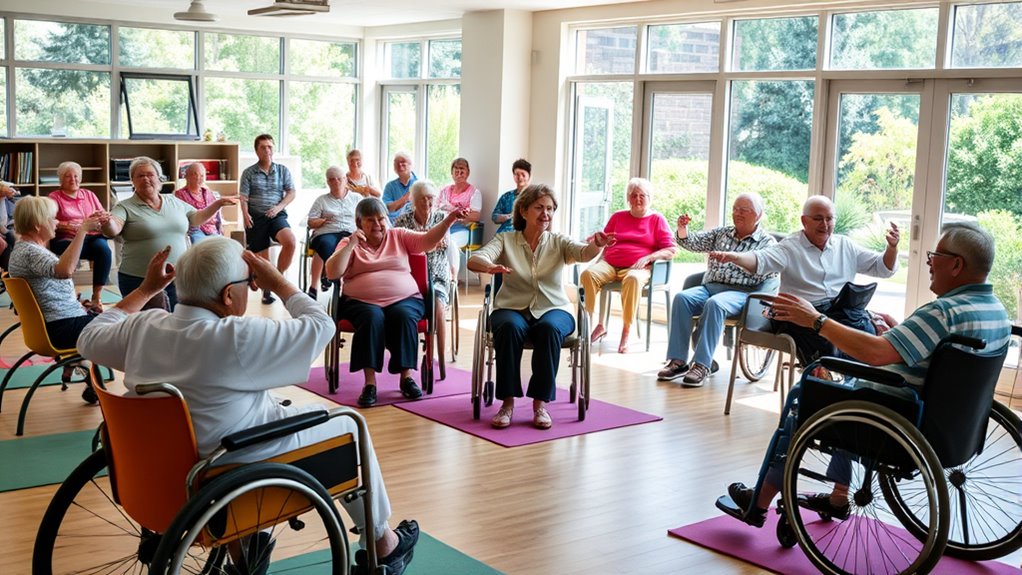
Accessing exercise programs tailored for seniors is essential for maintaining health and well-being. Community-based programs are designed for easy access, often held in convenient locations like senior centers and community halls. Many offer free or low-cost classes, ensuring financial accessibility. Additionally, incorporating low-impact exercises can help seniors improve strength and flexibility without risking injury.
You’ll find a range of activities, from yoga and swimming to chair exercises, catering to different mobility levels. Programs like Silver Sneakers and EnhanceFitness create supportive environments that foster social engagement, letting you connect with peers while staying active. Furthermore, small amounts of movement can yield significant health benefits, making it easier for seniors to start their exercise journey without feeling overwhelmed. This aligns with the idea that robust contingency plans can enhance overall well-being in various life aspects, including physical fitness. Furthermore, regular exercise not only supports physical health but also contributes to mental well-being, making it essential for seniors to remain active and engaged.
Additionally, understanding filial responsibility laws can encourage families to support seniors in accessing these programs, ensuring they remain active and healthy. Furthermore, technology integration, such as fitness apps, helps you track progress and stay motivated. With options available for various fitness levels, you can find the perfect fit to keep you engaged and thriving in your exercise journey.
Tailoring Exercise Routines to Individual Needs

Finding the right exercise program for seniors involves more than just accessibility; it’s about tailoring routines to meet individual needs.
First, confirm you have medical clearance before starting any exercise to cater to your health requirements. If you face mobility issues, consider chair yoga or modified strength training for safety. Low-impact aerobics can effectively enhance cardiovascular health while being gentle on your joints.
Incorporating strength training helps maintain muscle mass and bone density. Focus on exercises that improve daily activities, focusing on gradual progression to avoid injuries.
To enhance balance and flexibility, try tai chi or yoga, adjusting the difficulty as you progress. Tailored routines not only boost physical capabilities but also build your confidence over time.
The Importance of Variety in Exercise Activities
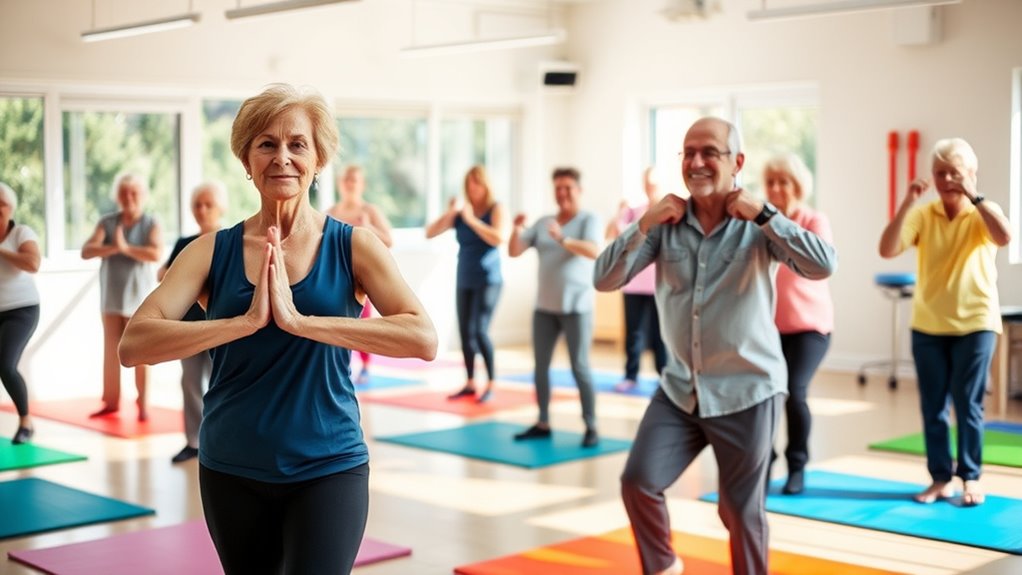
Incorporating a variety of exercise activities into your routine isn’t just beneficial—it’s essential for maintaining overall health and well-being as you age. Mixing endurance exercises like walking or swimming with strength training helps build muscle and improve functionality. Adding balance training reduces your risk of falls, boosting your confidence and safety.
Moreover, engaging in regular exercise not only enhances physical health but also supports cognitive function, making it vital for seniors. Variety also enhances mental well-being, reducing stress and improving your mood. Group classes foster social connections, combating feelings of isolation while keeping your workouts enjoyable and motivating. Plus, an active lifestyle can lead to better sleep quality. By diversifying your exercises, you’ll not only reap extensive physical benefits but also enhance your self-esteem and overall happiness.
Embrace variety for a thriving, active life!
Frequently Asked Questions
How Do I Choose the Right Exercise Class for My Needs?
Choosing the right exercise class for your needs starts with evaluating your fitness level and personal goals. Reflect on what interests you—whether it’s building strength, improving balance, or just having fun.
Look for experienced instructors who can guide you safely and offer modifications. Don’t forget to contemplate the class environment; a supportive group can keep you motivated.
Finally, explore local options or online classes that fit your schedule and preferences.
What Should I Wear to an Exercise Class?
So, you think you can just waltz into an exercise class in your favorite cotton tee and jeans? Think again!
Opt for moisture-wicking fabrics like polyester or spandex to keep dry. Make certain your clothes allow full movement, avoiding any tripping hazards.
Choose breathable tops and supportive footwear that won’t scream “I just rolled out of bed.”
Can I Participate if I Have Chronic Health Issues?
Yes, you can definitely participate even if you have chronic health issues.
It’s important to consult your healthcare provider first, but many programs are designed with your needs in mind. Trained instructors can adapt exercises to suit your abilities, ensuring you stay safe and engaged.
Regular participation can help manage your condition and improve your overall well-being. So, don’t hesitate to join; you’ll find supportive environments that cater to your unique situation.
How Can I Track My Progress in Exercise Classes?
Tracking your progress in exercise classes is like planting a garden; you need to monitor growth to see the fruits of your labor.
You can use fitness trackers to log your activity, set realistic goals, and maintain a digital diary to note improvements. Apps can remind you to stay on track, while regular assessments help adjust your routine.
Celebrate milestones along the way to keep your motivation blooming!
Are There Costs Associated With Participating in These Programs?
Yes, there’re costs associated with participating in various exercise programs. Depending on the program, you might pay a general membership fee, a reduced senior rate, or even nothing if your insurance covers it.
It’s crucial to contemplate what each program offers; some focus on gym access while others provide community classes. Evaluating the costs against potential health benefits can help you make a more informed decision about your fitness journey.
Conclusion
Incorporating exercise classes into your routine can make a world of difference in your life. Did you know that seniors who engage in regular physical activity can reduce their risk of chronic diseases by up to 30%? By staying active, you not only boost your physical health but also enhance your mental well-being and social connections. So, don’t wait—join a class that excites you, and embrace the vibrant, thriving life you deserve!
